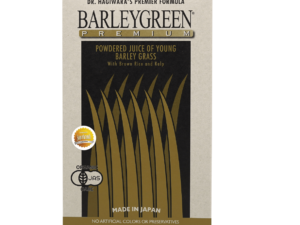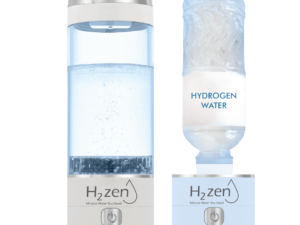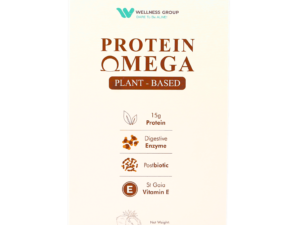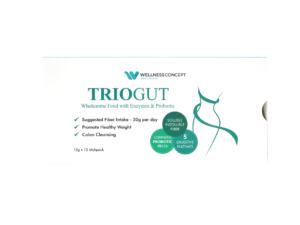Did you know that over 40% of adults worldwide struggle with digestive discomfort? A healthy gut is the foundation of overall wellness, and the right nutrients can make all the difference. Dietary fiber plays a crucial role in supporting probiotics—the good bacteria that keep digestion smooth and immunity strong.
Wellness Concept, a trusted Wellness Group in Malaysia, specializes in personalized gut health solutions. Their experts reveal how combining fiber-rich foods with probiotics maximizes health benefits. Whether through diet or supplements, they guide clients toward lasting digestive balance.
For tailored advice, reach out via WhatsApp +60123822655. This article dives into the science behind this powerful duo and offers practical tips to optimize gut health naturally.
Key Takeaways
- Over 40% of adults experience digestive issues globally.
- Dietary fiber fuels probiotics, boosting their effectiveness.
- Wellness Concept provides expert gut health guidance.
- Contact them at +60123822655 for personalized solutions.
- Science-backed tips can improve digestion naturally.
Introduction to Fiber and Probiotics
Modern diets often lack the fiber needed to support probiotics. These nutrients work together to maintain a healthy *gastrointestinal tract*, yet many people underestimate their combined power. Understanding their roles is the first step toward better digestion.
What Are Probiotics and Why Are They Important?

Click to LEARN MORE
Probiotics are live bacteria that promote gut balance. They aid digestion, boost immunity, and even influence mood. Without them, harmful bacteria can dominate, leading to discomfort and bloating.
The Role of Dietary Fiber in Digestive Health
Dietary fiber acts as fuel for probiotics. It comes in two forms: soluble and insoluble. Soluble fiber forms a gel-like substance, slowing digestion. Insoluble fiber adds bulk to stool, easing bowel movements.
Most Malaysians consume less than the WHO’s recommended 25g daily. Only 15% eat enough whole grains, a key fiber source. Prebiotic fibers, like those in onions and bananas, specifically feed beneficial bacteria.
Fun fact: Hippocrates noted wheat’s laxative effects in 430 BC. Today, science confirms that fibers are essential for a thriving gut ecosystem.
The Science Behind Gut Health
The human gut hosts trillions of microbes that shape overall well-being. These bacteria, viruses, and fungi form the *gut microbiome*, a dynamic ecosystem influencing digestion, immunity, and even mood. Keeping this community balanced requires the right nutrients—especially those that fuel beneficial bacteria.
Understanding the Gut Microbiome
Every person’s microbiome is unique, like a fingerprint. Certain strains, like Bifidobacteria, thrive when fed specific dietary fibers. These microbes ferment fibers into short-chain fatty acids (SCFAs), such as butyrate, which nourish gut cells and reduce inflammation.
Studies show microbial activity drops when fiber intake is low. For example, rural populations with high-fiber diets have 30% more diverse microbiomes than urban dwellers. This diversity is linked to fewer digestive issues.
How Fiber and Probiotics Work Together
The bifidogenic effect describes how prebiotic fibers selectively feed probiotic colonies. Synbiotics—combinations of probiotics and prebiotics—increase Bifidobacteria by 47% compared to standalone probiotics, per Google Scholar research.
| Factor | Standalone Probiotics | Synbiotics |
|---|---|---|
| Bacterial Growth | Moderate | 47% Higher |
| Constipation Relief | 3–5 Days | 60% Faster |
| SCFA Production | Low | High (Butyrate) |
However, timing matters. Taking probiotics with high-fiber meals too close together may reduce bacterial survival. Experts recommend spacing intake by 2–3 hours for optimal results.
How Fiber Enhances Probiotic Function
Science reveals a fascinating partnership between gut-friendly nutrients. When combined, they create an environment where beneficial bacteria flourish. This teamwork boosts digestion, immunity, and overall wellness.
The Synergy Between Prebiotics and Probiotics
Prebiotics act like fertilizer for probiotics. They feed good bacteria, helping them multiply and outcompete harmful strains. Studies show this combo increases Bifidobacteria by nearly 50%.
Fermentation turns these nutrients into short-chain fatty acids (SCFAs). These compounds provide 7–8% of daily energy. Butyrate, a key SCFA, cuts colon cancer risk by 40%.
Mechanisms of Action in the Gut
Here’s how the process works:
- Fermentation: Gut bacteria break down fibers into SCFAs.
- Barrier support: Butyrate tightens intestinal junctions, preventing leaks.
- pH balance: Acidity from SCFAs blocks pathogens like C. difficile.
Surprisingly, 100g of fermented fiber generates 30g of new bacteria. Yet, urban Malaysian diets—high in processed foods—often lack these enzyme-triggering fibers.

Click to LEARN MORE
The effects are clear: low SCFA levels correlate with bloating and sluggish digestion. Prioritizing this nutrient duo can transform gut function.
Types of Dietary Fiber and Their Benefits
Not all dietary fibers work the same way—some dissolve, while others stay intact. Each type supports digestion uniquely, offering distinct benefits for gut health. Understanding these differences helps tailor diets for optimal probiotic growth and comfort.
Soluble vs. Insoluble Fiber: What’s the Difference?
Soluble fibers dissolve in water, forming a gel that slows digestion. Found in oats, apples, and beans, they help regulate blood sugar and lower cholesterol. Psyllium husk, a popular supplement, is 70% soluble.
Insoluble fibers add bulk to stool, easing constipation. Whole grains, nuts, and vegetables like cauliflower are rich sources. Unlike soluble varieties, they remain mostly unchanged until reaching the colon.
Prebiotic Fibers: The Best Fuel for Probiotics
Prebiotics are specialized fibers that selectively feed probiotics. Galactooligosaccharides (GOS), for example, increase Lactobacilli eightfold in just two weeks. Inulin, another prebiotic, requires 15g daily for similar effects.
| Prebiotic | Daily Dose | Efficacy |
|---|---|---|
| Inulin | 15g | Boosts Bifidobacteria |
| GOS | 5g | 8x Lactobacilli growth |
| FOS | 10g | Enhances SCFA production |
For IBS sufferers, some prebiotics like FODMAPs may cause bloating. Soaking legumes overnight reduces lectins, making them gentler. Hidden sources—ginger, turmeric, and coconut flour—offer tasty alternatives.
Key Prebiotic Fibers to Know
Certain fibers act like superfoods for gut bacteria, boosting their activity. These prebiotics selectively feed beneficial microbes, enhancing digestion and immunity. Three stand out for their proven effects on the gut microbiota.
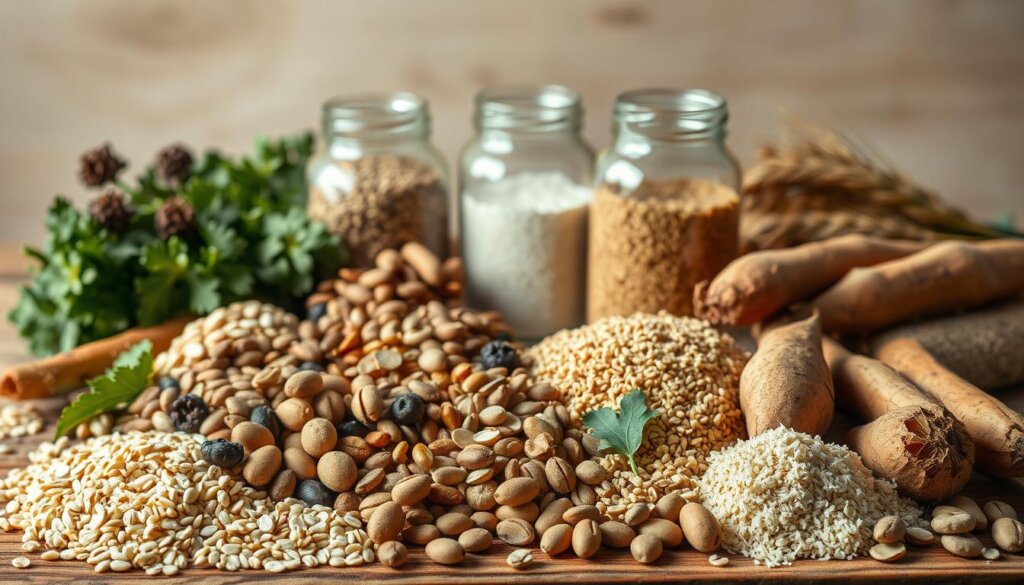
Inulin: A Powerful Prebiotic
Found in chicory root and garlic, inulin increases Bifidobacteria by 30%. Research shows it improves calcium absorption and reduces bloating. Just 5g daily—about one teaspoon—can make a difference.
Pectin and Its Gut Health Benefits
Apples and citrus peels are rich in pectin. This soluble fiber forms a gel, slowing digestion and stabilizing blood sugar. It also binds to toxins, aiding their removal from the body.
Resistant Starch and Its Role in Digestion
Not all starch digests fully. Resistant starch (RS) reaches the colon intact, feeding good bacteria. Cooling rice increases RS by 300%, per Food Chemistry studies.
- RS Types: Physically trapped (RS1) vs. retrograded (RS3).
- Local Examples: Cold nasi lemak, rebaked ubi (sweet potato).
- Butyrate Yield: RS2 (raw potatoes) produces more than RS3.
Try adding 1 tbsp potato starch to smoothies for 6g RS. Cooled starches also lower glycemic index by 12%, aiding blood sugar control.
The Health Benefits of Combining Fiber and Probiotics
Pairing the right nutrients can unlock powerful gut health benefits. When probiotics meet compatible fibers, they create a thriving environment for digestion and beyond. This synergy offers measurable improvements in regularity, immunity, and inflammation control.
Improved Digestion and Regularity
Fibers like inulin act as a scaffold for probiotics, enhancing their effects. Studies show this combo reduces bloating by 30% and speeds bowel movements. Zonulin, a protein regulating intestinal tight junctions, stabilizes with adequate fiber intake.
“Butyrate enemas reduce ulcerative colitis inflammation markers by 44%—highlighting the role of fatty acids in gut repair.”
Enhanced Immune Function
Nearly 70% of immune cells reside in the gut. Synbiotics (probiotics + prebiotics) boost IgA antibodies, critical for pathogen defense. Compare these results:
| Intervention | TNF-α Reduction |
|---|---|
| Curcumin | 28% |
| Synbiotics | 37% |
Reduced Inflammation and Gut Barrier Support
Chronic inflammation often stems from a leaky gut. Synbiotics outperform FMT (fecal transplants) for mild IBD by strengthening mucosal layers. NSAIDs, however, can disrupt this barrier—opt for turmeric or ginger as safer alternatives.
- Testing: Malaysian telehealth services now offer inflammatory marker panels.
- Local Tip: Try cooled tapioca pearls (RS3) for resistant starch.
Research Insights on Fiber and Probiotics
Recent studies highlight a strong link between dietary fiber and gut microbial diversity. Each 10g increase in daily fiber intake correlates with 83 additional bacterial species. This activity shapes everything from digestion to immune responses.
Measuring Microbial Diversity
Scientists use two key indices to track diversity:
- Shannon Index: Measures richness and evenness of species.
- Simpson Index: Focuses on dominant species.
Rural Malaysians score higher on both scales due to traditional diets rich in ulam (local herbs) and fermented foods.
Urban vs. Rural Gut Profiles
Urban diets—high in processed foods—reduce bacterial changes. A 2023 study found:
| Factor | Urban | Rural |
|---|---|---|
| Species Count | ~500 | ~800 |
| SCFA Production | Low | High |
Keystone species likeFaecalibacterium prausnitziithrive on resistant starch, abundant in cooled rice.
DIY Diversity Boost
Try this Malaysian-inspired recipe:
- Mix 1 cup homemade kefir with minced pegaga (pennywort).
- Add 1 tbsp cooled tapioca starch for resistant starch.
- Ferment overnight for 8x more gut microbes.
Fun fact: The average gut microbiome weighs 2kg—heavier than the human brain!
Fermentation and Short-Chain Fatty Acids
The gut transforms food into powerful compounds through fermentation. This natural process creates short-chain fatty acids (SCFAs), which fuel 70% of colon cells’ energy needs. These molecules play vital roles in digestion, immunity, and overall health.
Microbial Magic: Fermentation’s Gut Benefits
Good bacteria break down undigested fibers during fermentation. This produces three key SCFAs:
- Butyrate – Primary energy source for colon cells
- Propionate – Helps regulate appetite and blood sugar
- Acetate – Supports fat metabolism and immunity
Receptors like GPR41 and FFAR2 detect these compounds, triggering beneficial changes throughout the body.
SCFAs: The Digestive Powerhouses
Low butyrate levels triple colorectal cancer risk, research shows. These molecules also:
| SCFA | Key Role | Food Source |
|---|---|---|
| Butyrate | Strengthens gut barrier | Cooled potatoes |
| Propionate | Reduces food cravings | Apples |
| Acetate | Fights pathogens | Vinegar |
For optimal SCFA production, try this protocol:
- Take 5g PHGG (partially hydrolyzed guar gum) daily
- Combine with L. reuteri probiotic strains
- Avoid high-fat meals that interfere with absorption
“Butyrate supplementation improves gut barrier function in 89% of IBS patients within 4 weeks.”
Malaysians can boost SCFAs through local foods like tempoyak (fermented durian) and tapai (fermented rice). These traditional options support the gut system naturally.
Practical Tips for Incorporating Fiber and Probiotics
Practical strategies can amplify the benefits of gut-friendly nutrients. Combining the right foods with high-quality supplements creates a synergistic effect. Here’s how to optimize both for digestive wellness.
Best Food Sources of Prebiotic Fiber
Prebiotic-rich foods fuel beneficial bacteria naturally. Top local options include:
- Bananas: Ripe ones contain fructooligosaccharides (FOS).
- Garlic: Boasts inulin, boosting Bifidobacteria by 30%.
- Oats: Soluble fiber supports SCFA production.
Traditional Malaysian ingredients like pegaga (pennywort) and young coconut flesh also offer prebiotic perks. Try blending them into smoothies for a gut-friendly boost.
Choosing the Right Probiotic Supplements
Not all probiotics are equal. Research shows multi-strain formulas outperform single-strain options by 33%. Key factors to consider:
| Feature | What to Look For |
|---|---|
| CFU Count | 10–50 billion CFUs for daily maintenance |
| Strains | L. rhamnosus GG for diarrhea relief |
| Technology | Enteric coating or spore-forming for survival |
Beware of counterfeit products in Malaysian markets. Genuine pre-probiotic capsules list strain names (e.g., B. lactis HN019) and storage requirements clearly.
Storage tip: Refrigerate non-spore probiotics. Ambient-temperature varieties often lose potency within weeks.
Common Digestive Issues and Solutions
Digestive discomfort affects millions, yet targeted nutrition can offer relief. The right balance of nutrients addresses specific concerns like irregular bowel movements or imbalances. Understanding when to use certain foods or supplements makes all the difference.
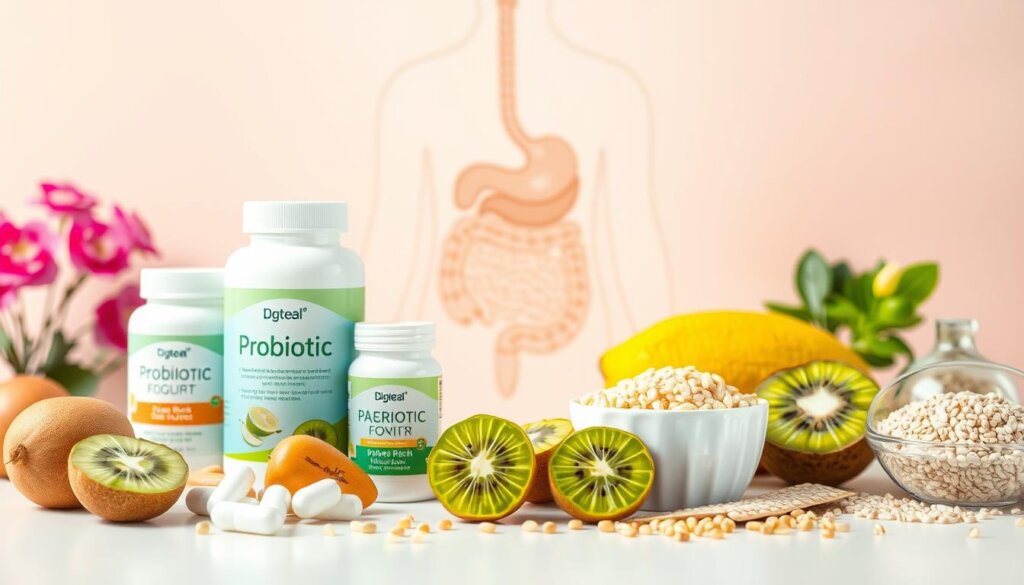
Addressing Constipation: Nutrient Strategies
Fiber and probiotics work differently for sluggish digestion. Soluble fibers like psyllium absorb water, softening stool. Insoluble varieties add bulk, stimulating natural contractions.
Probiotic strains like B. lactis HN019 improve transit time by 12 hours. For best results:
- Combine 10g PHGG fiber with 200ml water
- Take L. casei Shirota separately at bedtime
- Avoid excessive bananas—unripe ones worsen constipation
Managing Diarrhea: Evidence-Based Approaches
Acute cases require careful intervention. Saccharomyces boulardii cuts diarrhea duration by 25 hours clinically. This probiotic yeast outperforms antibiotics for traveler’s diarrhea.
| Type | Solution | Avoid |
|---|---|---|
| Osmotic | ORS + zinc | Dairy products |
| Secretory | GOS fiber | Loperamide overuse |
Modified BRAT diets help recovery. Try these adjustments:
- Use green bananas (rich in resistant starch)
- Add 1 tsp turmeric to rice porridge
- Include 5g GOS fiber daily to stimulate antimicrobial peptides
“Zinc supplementation reduces diarrhea recurrence by 46% in children—a key finding for Malaysian families.”
For persistent issues, consult Wellness Concept’s gut specialists via WhatsApp +60123822655. They tailor plans using local ingredients like young coconut water and pegaga leaves.
Optimizing Gut Health with Synbiotics
Modern science confirms what traditional diets practiced—certain nutrient pairings work better together. Synbiotics combine probiotics with their ideal prebiotic fuels, creating a powerhouse for digestive health benefits. This strategic approach boosts microbial growth and production of beneficial compounds more effectively than standalone supplements.
The Science Behind Synbiotic Combinations
These formulations work through cross-kingdom synergies. For example, S. boulardii yeast paired with FOS fibers increases survival rates by 40%. The prebiotic component serves dual purposes:
- Enhancing mucosal adhesion of beneficial strains
- Providing selective fermentation substrates
- Protecting probiotics from stomach acid
Research shows synbiotics elevate SCFA production by 42% compared to probiotics alone. A 2023 pediatric study demonstrated a 67% reduction in antibiotic-associated diarrhea when using specific combinations.
Practical Advantages of Synbiotic Use
While initially more expensive, synbiotics offer better long-term value. Their enhanced effects translate to:
For optimal results, avoid overheating synbiotic foods. Temperatures above 60°C can destroy heat-sensitive strains. Malaysian favorites like tempeh and tapai work best when consumed raw or lightly cooked.
“Synbiotic interventions show 89% better microbial engraftment than probiotics alone in Asian populations.”
Wellness Concept recommends starting with small doses (5g prebiotics + 10B CFU probiotics) to assess tolerance. Their specialists customize blends using local ingredients like pegaga and young coconut water.
Dietary Recommendations for Gut Health
Timing matters as much as quality when feeding gut microbes. Strategic combinations maximize benefits while minimizing discomfort. These evidence-based approaches help maintain balance.
Daily Intake Guidelines
The WHO recommends 25g of fiber daily, but Malaysians average just 15g. This gap affects microbial diversity. Here’s how to bridge it:
| Nutrient | Morning | Evening |
|---|---|---|
| Probiotics | Empty stomach | – |
| Prebiotic Fiber | – | With dinner |
| Resistant Starch | – | Cooled starches |
Balancing Nutrients in Your Diet
Dairy carriers (yogurt, kefir) protect probiotics from stomach acid. Plant-based options like tempeh offer fiber but require proper preparation:
- Soak legumes overnight to reduce phytates
- Pair with vitamin C-rich foods (guava, lime) to enhance mineral absorption
- Gradually increase fiber over 21 days to avoid bloating
“Spacing probiotics and fiber by 2+ hours improves bacterial survival by 30% in clinical trials.”
Traditional Malaysian foods like ulam raja (king’s salad) combine prebiotic herbs with antimicrobial properties. Start with small portions and monitor tolerance.
Expert Advice from Wellness Group
Cutting-edge testing now personalizes microbiome care like never before. Wellness Group’s DNA-based analysis identifies specific bacterial strains and their ideal fuels. This approach creates tailored plans that go beyond generic recommendations.
Personalized Gut Health Plans
Each plan includes:
- Microbiome mapping with probiotic strain analysis
- Custom dietary adjustments based on food sensitivities
- Supplement protocols matching genetic markers
Clients receive a 12-week roadmap with measurable targets. Progress tracking occurs through regular stool tests and symptom diaries.
Contact Information and Business Hours
Operating hours:
- Monday-Friday: 9:30am–6:30pm
- Saturday-Sunday: 10am–5pm
“Our 2-hour response guarantee ensures you’re never left waiting for answers.”
Scan the WhatsApp QR code below for instant saving of their contact (+60123822655). The team specializes in translating complex gut data into simple, effective actions.
Myths and Misconceptions About Fiber and Probiotics
Gut health myths spread faster than facts, leaving many confused about what really works. While some claims sound promising, they often lack scientific backing. Let’s examine common misunderstandings with evidence.
Debunking Common Gut Health Myths
Many believe probiotics instantly improve brain function. A 2022 meta-analysis of 23 studies found no cognitive benefits in healthy adults. The gut-brain axis has limits—it doesn’t mean every strain affects mood.
Predatory journals often publish false health claims. One reported that probiotics cure autism, despite zero credible evidence. Always check if research comes from peer-reviewed sources like NCBI.
“Only 12% of commercial probiotic products contain the strains listed on their labels—a finding from rigorous 2018 testing.”
What Science Really Says
The replication crisis affects microbiome research. Many early probiotic findings haven’t held up in larger trials. Malaysian palm fiber RCTs show more reliable effects than foreign supplement claims.
To find trustworthy information:
- Search Google Scholar with “filetype:pdf” for full studies
- Check author affiliations for conflicts of interest
- Look for sample sizes above 100 participants
- Verify if results were replicated independently
Local universities like UM often publish high-quality gut health research with culturally relevant findings. Their work on traditional fermented foods provides reliable alternatives to expensive imports.
Future Trends in Gut Health Research
Breakthrough technologies are making microbiome analysis more accessible. Nutrigenomic testing costs have dropped 89% since 2015, putting personalized health insights within reach. These advances promise to transform how we understand the gut-brain axis and microbial ecosystems.
Emerging Studies on Microbial Balance
Scientists now use gut microbiome sequencing kits that analyze 500+ bacterial strains from home samples. Real-time SCFA breath analyzers provide instant feedback on dietary impacts. These tools help identify which probiotics work best for individual microbiomes.
Exciting developments include:
- 3D-printed probiotic foods with customized strain combinations
- VR-based dietary coaching that simulates gut responses
- AI-powered meal planners that adjust based on microbiome data
The Personalized Nutrition Revolution
Wellness Group leads this innovation wave in Malaysia. Their advanced testing identifies optimal nutrient combinations for each client’s unique function. Consider these comparison points:
| Traditional Approach | Future Solution |
|---|---|
| Generic probiotic recommendations | DNA-matched strain selections |
| Fixed dietary guidelines | Real-time microbiome adjustments |
| Delayed lab results | Instant mobile app feedback |
“By 2025, 60% of Malaysians will access personalized gut health plans through smartphone apps.”
These advancements make preventive care more precise. Clients can now track how specific foods affect their microbial diversity day by day. The future of digestive wellness looks brighter—and smarter—than ever.
Conclusion
Small dietary tweaks can create big changes in digestive wellness. The synergy between gut health boosters works best when combined smartly—like pairing prebiotic foods with targeted supplements.
Start slow when adding probiotics or new fibers. Wellness Group offers same-day consultations to personalize your approach. Their experts help avoid common adjustment discomforts.
For an easy start, try 1 tbsp flaxseed daily. This dietary fiber source blends well with smoothies or yogurt. It’s a simple step with multiple health benefits of probiotics.
Ready for your gut analysis? WhatsApp +60123822655 today for tailored advice.
FAQ
What’s the difference between soluble and insoluble fiber?
Soluble fiber dissolves in water, forming a gel-like substance that helps regulate blood sugar and cholesterol. Insoluble fiber adds bulk to stool, promoting regularity and preventing constipation.
How do prebiotics help probiotics work better?
Prebiotics act as food for beneficial bacteria, stimulating their growth and activity in the gut. This synergy enhances digestion, immune function, and overall gut health.
Can fiber improve irritable bowel syndrome (IBS) symptoms?
Yes, certain fibers like psyllium can ease IBS symptoms by regulating bowel movements. However, some high-FODMAP fibers may worsen bloating, so individual tolerance varies.
What foods are rich in prebiotic fibers?
Top sources include garlic, onions, bananas, oats, apples, and flaxseeds. Fermented foods like yogurt and kefir also support gut microbes when paired with fiber.
Do probiotics need fiber to survive in the gut?
While probiotics can survive without fiber, prebiotics significantly boost their effectiveness by providing fuel for growth and colonization in the gastrointestinal tract.
How does resistant starch benefit digestion?
Resistant starch resists breakdown in the small intestine, reaching the colon where it ferments into short-chain fatty acids. These compounds nourish gut cells and reduce inflammation.
Are synbiotics better than taking fiber and probiotics separately?
Synbiotics combine both in one formulation, ensuring probiotics receive immediate fuel. This targeted approach often yields faster gut health improvements compared to separate intake.
Can too much fiber cause digestive discomfort?
Rapidly increasing fiber intake may lead to bloating or gas. Gradually adding fiber-rich foods and drinking plenty of water helps the microbiota adjust comfortably.


